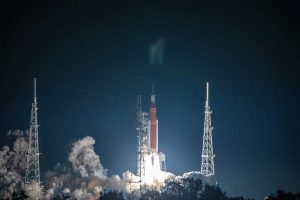SLS, Powered by Boeing, A Look Back at November Launch
January 2, 2023 – The space industry continues to dazzle with impressive achievements. Returning humans to the Moon has to rank at the very top of this list. Titusville serves as the headquarters location for Boeing’s Space and Launch Division, and the aerospace leader has a major role in this endeavor. The following is a detailed look at what this role involves. From the Boeing company:
NASA’s Space Launch System rocket, powered by the Boeing-built core stage, lifted off at 1:47 a.m. ET from the Kennedy Space Center on November 16. Eight and a half minutes into flight, the core stage completed its mission and separated from the upper stage of the rocket, sending NASA’s Orion spacecraft on its first journey around the Moon.

Image credit: Boeing
“Today, this country now has a super-heavy lift launch capability for the first time in 50 years,” said Jim Chilton, senior vice president of Boeing’s Space and Launch division. “This test flight was a demonstration of engineering innovation, and we are ready to support NASA and their international partners in returning humans to deep space exploration.”
During the mission, the core stage demonstrated several important functions, including fueling both tanks, actuating the hydraulic system, igniting the engines, running thrust vector control programs in flight, depleting the fuel tanks, shutting down the engines, and conducting successful separation and disposal maneuvers.
“It was an absolutely beautiful launch – visually and technically,” said John Shannon, vice president and program manager of Boeing’s SLS program. “This rocket controls incredible forces while speeding through the atmosphere. It performed the mission as we designed it to do, and we thank our team and partners for all their hard work in making this first launch a success.”
The core stage of the rocket stands at 212 feet (almost 65 meters), and is comprised of a 196,000-gallon liquid oxygen, a 537,000-gallon liquid hydrogen tank, along with an intertank section joining the two fuel reservoirs, a forward skirt on top that connects to the upper stage, and an engine section with four RS-25 engines combining for 2.2 million pounds of thrust. A Boeing team manufactures the core stage at NASA’s Michoud Assembly Facility in New Orleans, Louisiana, and uses components made by more than 430 suppliers across the United States.
The Boeing team is preparing the next stages for their respective flights. Core Stage-2, or CS-2, will launch the first crew of the Artemis program and is in the final assembly area at Michoud. CS-3 is manifested to launch the first crewed lunar landing since Apollo, which will include the first woman and first person of color. That stage, as well as CS-4, are already in work at Michoud. Additionally, the structural test article of a newer, more powerful upper stage known as the Exploration Upper Stage is in fabrication.
As a leading global aerospace company, Boeing develops, manufactures and services commercial airplanes, defense products and space systems for customers in more than 150 countries.







